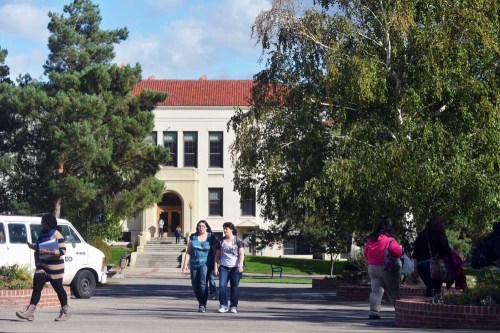Oregon higher ed budget bill would increase access to financial aid
Published 8:42 am Wednesday, June 16, 2021

- Students walk through a courtyard on the Eastern Oregon University campus in La Grande. Nearly 11,000 more students would have access to a state financial aid program in the next two years thanks to increased state funding in a higher education budget bill continuing to make its way through the Oregon Legislature.
SALEM — Roughly 11,000 more students would have access to a state financial aid program in the next two years thanks to increased state funding in a higher education budget bill continuing to make its way through the Oregon Legislature.
The Legislature’s Joint Ways and Means Subcommittee on Education voted Monday, June 14, to send Senate Bill 5528 to the full Joint Ways and Means Committee with a “do pass” recommendation.
If passed, the bill would increase funding for programming and operations at Oregon’s public universities and community colleges over current levels. The bill also allocates more money to the Oregon Opportunity Grant, a state-funded grant program for low-income students.
Connie Green, interim President at Blue Mountain Community College, Pendleton, said this is an investment in Oregon that can help so many students.
Oregon has 17 community colleges, but the funding is not split evenly between them. Rather, Green explained, the funding will be based on a community college’s three-year average of full time enrollment. Under that formula, Portland Community College, the largest in Oregon, would get the most funds.
Blue Mountain’s enrollment during the past three years has slipped, Green said, and the college will not know just how much it gets until sometime in July, when the final tally for spring term enrollment comes in.
But the college does know what it will do with the funds — build back its reserve.
“We’ve been using the reserves to balance the budget,” Green said.
Putting the funds into the reserve coffer gives BMCC a buffer in case the funding is not part of the next biennium.
“That way we’re ready for the next session,” Green said.
Tim Seydel, vice president for university advancement at Eastern Oregon University, said the budget does not give the college a big bonus but allows it continues services.
“For EOU, it means we were able to hold tuition flat for the upcoming year,” he said.
According to the Higher Education Coordinating Commission, from 2009 to 2019, more than 2 million applications for financial aid were eligible for Oregon Opportunity Grant funds, but only about 16% of those students received grants because of limited available funding.
Oregon Gov. Kate Brown initially recommended funding for the Oregon Opportunity Grant at about $171 million last December. If lawmakers pass the most recent iteration of a budget bill, the grant would stand at $200 million for the upcoming two-year budget period.
The Oregon Higher Education Coordinating Commission says that extra bump of funding would increase the total number of grant recipients from roughly 65,600 to about 76,600 in the upcoming biennium.
“That is really important, especially for students in this region because we have a lot of students with financial need who want to go to college,” Seydel said. “That Oregon Opportunity Grant makes it possible.”
Seydel said the pandemic has many students having to make tough financial decisions, but the increased funds could make college a reality for more of them.
Along with the increased funding to the Oregon Opportunity Grant, lawmakers are also examining changes to another state financial aid program — the Oregon Promise.
The Oregon Promise was created in 2015 to help cover most tuition costs at Oregon community colleges for recent high school graduates and GED recipients. At the time it was announced, Oregon Promise was touted as the state’s “free community college” financial aid program.
Another bill in the Legislature would broaden the program’s focus and change who’s eligible to use it. House Bill 2093 would expand the eligibility requirements for the program and make other changes such as: lowering the grade point average requirement for students from 2.5 to 2.0, doubling the minimum grant award to $2,000 and cutting a $50 per term copay.
Notably, the bill also would expand the permitted uses of the grant funds to include students not only looking to attend community colleges, but also public universities and nonprofit, regionally accredited private institutions.
Still, key changes remain between the Oregon Promise and the Oregon Opportunity Grant — the Oregon Promise is only available to recent high school and GED graduates, while the Opportunity Grant is available to students of all ages. In addition, the Oregon Promise only offers up to two years of grant funding, while the Opportunity Grant offers grants for up to four years.
The Higher Education Coordinating Commission said the bill looking to tweak the Oregon Promise has undergone some changes since it was first introduced at the beginning of this year, but regardless, the agency says the bill would “improve the equity of the Oregon Promise program and its flexibility for students.”
“These are important positive steps,” the commission said. “But even if this bill passes in current or amended form, financial aid programs will still need to be funded at increased levels to fully address the serious affordability challenges students and families face.”
The commission said policy changes such as this are a “first step toward a more wholesale redesign of financial aid to meet the needs of Oregonians.”
— EO Media Group contributed to this report.






